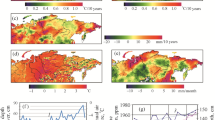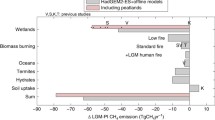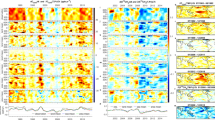Abstract
The atmosphere-ocean general circulation model with the carbon cycle is coupled to a model of methane evolution, in which methane sources in the soil of wetlands and methane evolution in the atmosphere are calculated. A numerical experiment on the simulation of climate and methane-cycle changes in 1860–2100 has been conducted with the model forced by methane emissions prescribed from scenario A1B. The distribution of the sources of methane from soil agrees with the available estimates and amounts to about 240 Mt/year in the 20th century. The methane flux from soil increases to 340 Mt/year by the end of the 21st century. The model adequately reproduces an increase in the atmospheric methane concentration from 800 ppb in 1860 to about 1800 ppb in 2000, but does not produce the observed stabilization of methane concentration in the early 21st century. By 2060, the methane concentration in the model attains 2700 ppb. The increase in atmospheric methane concentration is due mainly to anthropogenic emissions. A similar numerical experiment with fixed sources of methane from soil at the 1860–1900 level suggests that the maximum methane concentration in the model in this case could amount to 2400 ppb. A temperature increase at the end of the 21st century relative to the 19th century is 3.5° for a simulated change in the methane flux from soil and 0.25° less for a fixed methane flux.
Similar content being viewed by others
References
E. M. Volodin, “Atmosphere-Ocean General Circulation Model with the Carbon Cycle,” Izv. Akad. Nauk, Fiz. Atmos. Okeana 43, 298–313 (2007) [Izv., Atmos. Ocean. Phys. 43, 266–280 (2007)].
P. Friedlingstein, P. Cox, R. Betts, et al., “Climate-Carbon Cycle Feedback Analysis, Results from the C4MIP Model Intercomparison,” J. Clim. 19, 3337–3353 (2006).
T. J. Osborn and T. Wigley, “A Simple Model for Estimating Methane Concentration and Lifetime Variations,” Clim. Dyn. 9, 181–193 (1994).
Q. Zhuang, J. M. Melillo, D. W. Kicklighter, et al., “Methane Fluxes between Terrestrial Ecosystems and the Atmosphere at Northern High Latitudes during the Past Century: A Retrospective Analysis with a Process-Based Biogeochemistry Model,” MIT Joint Program on the Science and Policy of Global Change. Report No. 108. Available at http://mit.edu.globalchange
N. A. Diansky and E. M. Volodin, “Simulation of Present-Day Climate with a Coupled Atmosphere-Ocean General Circulation Model,” Izv. Akad. Nauk, Fiz. Atmos. Okeana 38, 824–840 (2002) [Izv., Atmos. Ocean. Phys. 38, 732–747 (2002)].
E. M. Volodin and N. A. Diansky, “Simulation of Climate Changes in the 20th–22nd Centuries with a Coupled Atmosphere-Ocean General Circulation Model,” Izv. Akad. Nauk, Fiz. Atmos. Okeana 42, 291–306 (2006) [Izv., Atmos. Ocean. Phys. 42, 267–281 (2006)].
G. B. Bonan, “A Land Surface Model (LSM Version 1.0) for Ecological, Hydrological and Atmospheric Studies: Technical Description and User’s Guide,” NCAR Technical Note, 417 (1996).
E. M. Volodin and V. N. Lykosov, “Parametrization of Heat and Moisture Transfer in the Soil-Vegetation System for Use in Atmospheric General Circulation Models: 2. Numerical Experiments in Climate Modeling,” Izv. Akad. Nauk, Fiz. Atmos. Okeana 34, 622–633 (1998) [Izv., Atmos. Ocean. Phys. 34, 559–569 (1998)].
E. Matthews and I. Fung, “Methane Emissions from Natural Wetlands: Global Area, Distribution and Environmental Characteristics of Sources,” Global Biogeochem. Cycles 1(1), 61–86 (1987).
Climate Change 2001. The Scientific Basis. Intergovernmental Panel on Climate Change, Ed. by J. T. Houghton, Y. Ding, D. J. Gridds, et al. (Cambridge, 2001).
G. Marland, T. A. Boden, and R. J. Andres, “Global, Regional and National CO2 Emissions,” in Trends: A Compendium of Data on Global Change (Carbon Dioxide Information Analysis Center, 2005).
F. Keppler, J. Hamilton, M. Brass, and T. Rockmann, “Methane Emissions from Terrestrial Plants under Aerobic Conditions,” Nature 439(7075), 487–491 (2006).
B. P. Walter, M. Heinmann, and E. Mattews, “Modeling Modern Methane Emissions from Natural Wetlands. 1. Model Description and Results,” J. Geophys. Res. D 106, 34189–34206 (2001).
M. Cao, K. Gregson, and S. Marshall, “Global Methane Emissions from Natural Wetlands: Application of a Process-Based Model,” J. Geophys. Res. D 101, 14 399–14 414 (1996).
B. P. Walter, M. Heinmann, and E. Mattews, “Modeling Modern Methane Emissions from Natural Wetlands. 2. Interannual Variations in 1982–1993,” J. Geophys. Res. D 106, 34207–34219 (2001).
Author information
Authors and Affiliations
Corresponding author
Additional information
Original Russian Text © E.M. Volodin, 2008, published in Izvestiya AN. Fizika Atmosfery i Okeana, 2008, Vol. 44, No. 2, pp. 163–170.
Rights and permissions
About this article
Cite this article
Volodin, E.M. Methane cycle in the INM RAS climate model. Izv. Atmos. Ocean. Phys. 44, 153–159 (2008). https://doi.org/10.1134/S0001433808020023
Received:
Accepted:
Published:
Issue Date:
DOI: https://doi.org/10.1134/S0001433808020023




